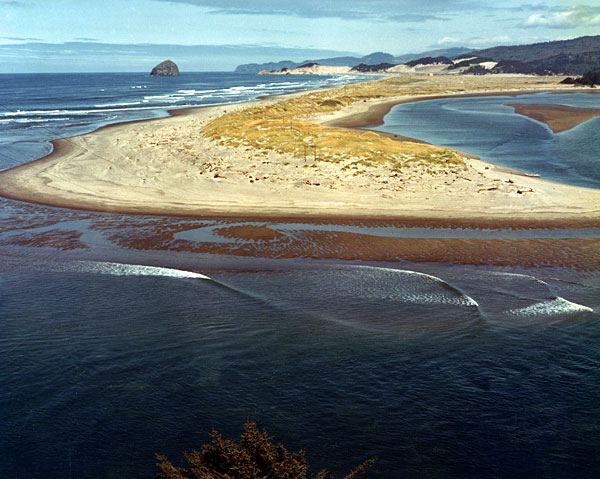 An aerial view of the Nestucca Spit and the mouth of the Nestucca River near Pacific City in 1966. (Western Oregon University Archives, Robert W. Straub Collection)
An aerial view of the Nestucca Spit and the mouth of the Nestucca River near Pacific City in 1966. (Western Oregon University Archives, Robert W. Straub Collection)
Nestucca Spit
While great attention was paid to the passage of the Beach Bill in 1967, questions about the fate of Nestucca Spit had been percolating since 1965. The Oregon Highway Commission, and its powerful chairman, Glenn Jackson, sought to reroute U.S. Highway 101 along the spit of sand as part of a larger effort to straighten and widen many stretches of the highway—both for safety and to enhance public access. The plan met resistance from property owners and environmentalists but was approved in 1965. Opponents, including Bob Straub, contended that, among other things, it would ruin a long stretch of unspoiled beach.
Straub highlighted his opposition to the highway plan during his losing 1966 campaign for governor against Tom McCall, a supporter. With McCall in the governor's office, it appeared as if the plan would move forward, but Straub kept fighting. Part of the route passed through land that had been granted to the state by the federal Bureau of Land Management (BLM) on the condition that it would remain in a natural state.
The state had petitioned the BLM to allow the highway anyway, but Straub went to Washington, D.C. and personally prevailed on Secretary of the Interior, Stewart Udall, to deny the request. McCall dropped his support for the plan but Glenn Jackson made another effort, this time to route the highway around the former BLM land on the spit. However, Straub kept up the pressure and the proposal officially died in early 1968.
A 1000-member group called the Committee to Save the Beaches had formed in 1965 to oppose the highway plan. This group later evolved into Beaches Forever, Inc., which spearheaded the broader Measure 6 campaign in 1968 to help protect all Oregon beaches.